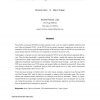Free Online Productivity Tools
i2Speak
i2Symbol
i2OCR
iTex2Img
iWeb2Print
iWeb2Shot
i2Type
iPdf2Split
iPdf2Merge
i2Bopomofo
i2Arabic
i2Style
i2Image
i2PDF
iLatex2Rtf
Sci2ools
ICMCS
1997
IEEE
1997
IEEE
A Novel Video Layout Strategy for Near-Video-on-Demand Servers
Near-Video-on-Demand (NVOD) provides customers with a service model completely different from true Video-on-Demand (VOD). In the NVOD service model, customers’ requests are not serviced immediately. NVOD servers typically support limited VCR functions. Since the NVOD service needs to be much cheaper than the VOD service, it is important to minimize the server’s cost. In this paper, we present a novel video layout strategy for NVOD servers that enforce sequential disk access. Thus, the disk bandwidth is optimally utilized. We define a model that analyzes the storage subsystem behavior, buffer requirements, and usage. Strategies that match the actual disk bandwidth to the application bandwidth requirements are developed. Using this layout strategy, each disk can deliver 50% more streams than can a VOD system, and memory buffers are reduced by almost half. Since disks and memory account for a significant portion of the total system cost in a video server, using these strategies signi...
ICMCS 1997 | Multimedia | NVOD | Nvod Server | NVOD Service |
| Added | 06 Aug 2010 |
| Updated | 06 Aug 2010 |
| Type | Conference |
| Year | 1997 |
| Where | ICMCS |
| Authors | Shenze Chen, Manu Thapar |
Comments (0)

